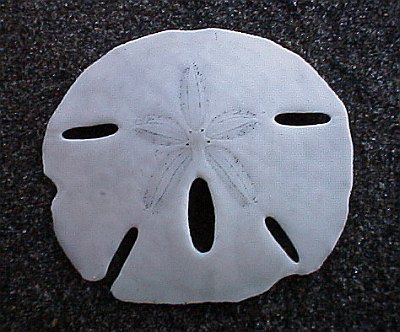What is a sand dollar?
Sand dollars are of the Phylum Echinodermata, class Echinoidea. They, like the sea urchin, have no arms or legs but move around by tiny spines on their body. Sand dollars are usually found lying in a bed buried under a layer of sand. If a sand dollar is found alive it will appear to have a layer of very fine hair on its body. These are the spines. They are a slow moving grazer that feeds on disintegrating organic material found within their sand beds. (http://www.seashells.org/identcatagories/sanddollarstypes.htm)
Children have been known to say that sand dollars are pressed sand that has been dried or even the money of mermaids washed-up from the deep. In reality, the fragile disk is the skeleton or “test” of a marine animal. By the time the test washes up on the beach it is missing its velvety covering of minute spines and appears somewhat bleached from the sun. It is hard to believe it was once alive. Sand dollars are from the class of marine animals known as Echinoids, spiny skinned creatures. Their relations include the sea lily, the sea cucumber, the star fish and the sea urchin. When alive, the local species, Echinarachnius parma is outfitted in a maroon-colored suit of moveable spines that encompass the entire shell. Like its close relative the sea urchin, the sand dollar has five sets of pores arranged petal pattern. The pores are used to move sea water into its internal water-vascular system which allows for movement. Sand dollars live beyond mean low water on top of or just beneath th
A sand dollar is a marine animal named after its flattish, round shape that resembles a large coin. Sand dollars belong to a class of animals known as Echinoids and are close relatives of the sea urchin and starfish. Many people are familiar with sand dollars that have washed up on the beach, becoming bleached by the sun to a light sandy color. When a sand dollar is alive however, it is darker in color and covered by tiny, mobile spines. A sand dollar has a characteristic 5-petal design on its back produced by sets of large pores. In a living sand dollar, rows of tiny tubular feet extend up through the pores. These respiratory stalks or podia act as gills by flushing water through the sand dollar to keep the animal oxygenated. Most species of sand dollars live on or just under the seabed in muddy or sandy areas at depths of about 30–40 feet (~9-12 meters). The tiny spines covering their exoskeletons are covered with minute hairs, or cilia. On the underside of the animal, these spines a
Children have been known to say that sand dollars are pressed sand that has been dried or even the money of mermaids washed-up from the deep. In reality, the fragile disk is the skeleton or “test” of a marine animal. By the time the test washes up on the beach it is missing its velvety covering of minute spines and appears somewhat bleached from the sun. It is hard to believe it was once alive. Sand dollars are from the class of marine animals known as Echinoids, spiny skinned creatures. Their relations include the sea lily, the sea cucumber, the star fish and the sea urchin. When alive, the local type, Echinarachnius parma is outfitted in a maroon-colored suit of moveable spines that cover the whole shell. Like its close relative the sea urchin, the sand dollar has five sets of holes arranged petal pattern. Tube feet stuck out from these holes and were used for breathing and eating. Sand dollars live beyond low water on top of or just beneath the surface of sandy or muddy areas. The s
This is some Time Lapse video I shot of a very active Sand Dollar moving across the sand in the afternoon. It has a clump of sand on top of it. I have always seen these when I was a kid, but now my fascination with them has really been sparked. The eat plankton and are related to Sea Urchins (they eat sea plants). Some of these Sand Dollars move in a straight line, some go in a circle around and around. Others zig-zag back and forth. I know they seem to have an exoskeleton but WHAT are they? I cant seem to find a lot of detailed information about these creatures and their habits online. Has anyone ever seriously studied the behavior of these creatures? I don’t know if they have a brain, but without one, how do they make decisions? Some seem to bury themselves in the sand.



